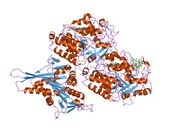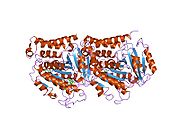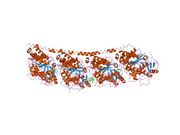Biology:Alpha-tubulin 3C
 Generic protein structure example |
Tubulin alpha-3C/D chain is a protein that in humans is encoded by the TUBA3C gene.[1][2]
Function
Microtubules of the eukaryotic cytoskeleton perform essential and diverse functions and are composed of a heterodimer of alpha and beta tubulin. The genes encoding these microtubule constituents are part of the tubulin superfamily, which is composed of six distinct families. Genes from the alpha, beta and gamma tubulin families are found in all eukaryotes. The alpha and beta tubulins represent the major components of microtubules, while gamma tubulin plays a critical role in the nucleation of microtubule assembly. There are multiple alpha and beta tubulin genes and they are highly conserved among and between species. This gene is an alpha tubulin gene that encodes a protein 99% to the mouse testis-specific Tuba3 and Tuba7 gene products. This gene is located in the 13q11 region, which is associated with the genetic diseases Clouston hidrotic ectodermal dysplasia and Kabuki syndrome. Alternative splicing has been observed for this gene and two variants have been identified.[2]
Interactions
Alpha-tubulin 3C has been shown to interact with FYN[3] and NMI.[4]
References
- ↑ "Sequence characterization of a newly identified human alpha-tubulin gene (TUBA2)". Genomics 47 (1): 125–30. Jan 1998. doi:10.1006/geno.1997.5081. PMID 9465305.
- ↑ 2.0 2.1 "Entrez Gene: TUBA3C tubulin, alpha 3c". https://www.ncbi.nlm.nih.gov/sites/entrez?Db=gene&Cmd=ShowDetailView&TermToSearch=7278.
- ↑ "Process outgrowth of oligodendrocytes is promoted by interaction of fyn kinase with the cytoskeletal protein tau". The Journal of Neuroscience 22 (3): 698–707. Feb 2002. doi:10.1523/JNEUROSCI.22-03-00698.2002. PMID 11826099.
- ↑ "Towards a proteome-scale map of the human protein-protein interaction network". Nature 437 (7062): 1173–8. Oct 2005. doi:10.1038/nature04209. PMID 16189514. Bibcode: 2005Natur.437.1173R.
External links
- Human TUBA3C genome location and TUBA3C gene details page in the UCSC Genome Browser.
Further reading
- "Tubulin and FtsZ structures: functional and therapeutic implications". BioEssays 20 (7): 523–7. Jul 1998. doi:10.1002/(SICI)1521-1878(199807)20:7<523::AID-BIES1>3.0.CO;2-L. PMID 9722999.
- "An abundance of tubulins". Trends in Cell Biology 10 (12): 537–42. Dec 2000. doi:10.1016/S0962-8924(00)01857-2. PMID 11121746.
- "The tubulin fraternity: alpha to eta". Current Opinion in Cell Biology 13 (1): 49–54. Feb 2001. doi:10.1016/S0955-0674(00)00173-3. PMID 11163133.
- "The N-terminal domain of c-Myc associates with alpha-tubulin and microtubules in vivo and in vitro". Molecular and Cellular Biology 15 (9): 5188–95. Sep 1995. doi:10.1128/MCB.15.9.5188. PMID 7651436.
- "A YAC contig and an EST map in the pericentromeric region of chromosome 13 surrounding the loci for neurosensory nonsyndromic deafness (DFNB1 and DFNA3) and limb-girdle muscular dystrophy type 2C (LGMD2C)". Genomics 29 (1): 163–9. Sep 1995. doi:10.1006/geno.1995.1227. PMID 8530067.
- "Human T lymphocyte activation induces tyrosine phosphorylation of alpha-tubulin and its association with the SH2 domain of the p59fyn protein tyrosine kinase". European Journal of Immunology 25 (12): 3290–7. Dec 1995. doi:10.1002/eji.1830251214. PMID 8566014.
- "I kappaB alpha physically interacts with a cytoskeleton-associated protein through its signal response domain". Molecular and Cellular Biology 17 (12): 7375–85. Dec 1997. doi:10.1128/MCB.17.12.7375. PMID 9372968.
- "A radiation hybrid map of 48 loci including the clouston hidrotic ectodermal dysplasia locus in the pericentromeric region of chromosome 13q". Genomics 56 (1): 127–30. Feb 1999. doi:10.1006/geno.1998.5698. PMID 10036193.
- "Paxillin localizes to the lymphocyte microtubule organizing center and associates with the microtubule cytoskeleton". The Journal of Biological Chemistry 275 (34): 26436–40. Aug 2000. doi:10.1074/jbc.M003970200. PMID 10840040.
- "HIV-1 rev depolymerizes microtubules to form stable bilayered rings". The Journal of Cell Biology 150 (2): 349–60. Jul 2000. doi:10.1083/jcb.150.2.349. PMID 10908577.
- "Identification of an alpha-tubulin mutant of fission yeast from gamma-tubulin-interacting protein screening: genetic evidence for alpha-/gamma-tubulin interaction". Journal of Cell Science 113 (24): 4557–62. Dec 2000. doi:10.1242/jcs.113.24.4557. PMID 11082048.
- "SIAH-1 interacts with alpha-tubulin and degrades the kinesin Kid by the proteasome pathway during mitosis". Oncogene 19 (52): 5997–6006. Dec 2000. doi:10.1038/sj.onc.1204002. PMID 11146551.
- "Binding of heterochromatin protein 1 to the nuclear envelope is regulated by a soluble form of tubulin". The Journal of Biological Chemistry 276 (16): 13007–14. Apr 2001. doi:10.1074/jbc.M007135200. PMID 11278332.
- "Prefoldin recognition motifs in the nonhomologous proteins of the actin and tubulin families". The Journal of Biological Chemistry 276 (44): 41023–8. Nov 2001. doi:10.1074/jbc.M106591200. PMID 11535601.
- "Process outgrowth of oligodendrocytes is promoted by interaction of fyn kinase with the cytoskeletal protein tau". The Journal of Neuroscience 22 (3): 698–707. Feb 2002. doi:10.1523/JNEUROSCI.22-03-00698.2002. PMID 11826099.
- "Interaction between metabotropic glutamate receptor 7 and alpha tubulin". Journal of Neurochemistry 80 (6): 980–8. Mar 2002. doi:10.1046/j.0022-3042.2002.00778.x. PMID 11953448.











